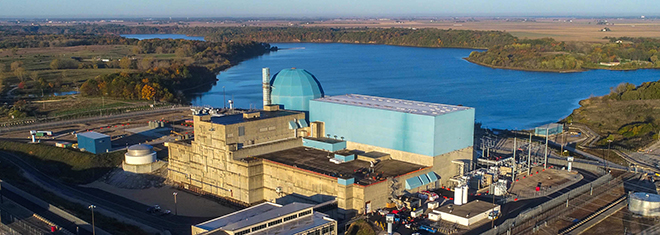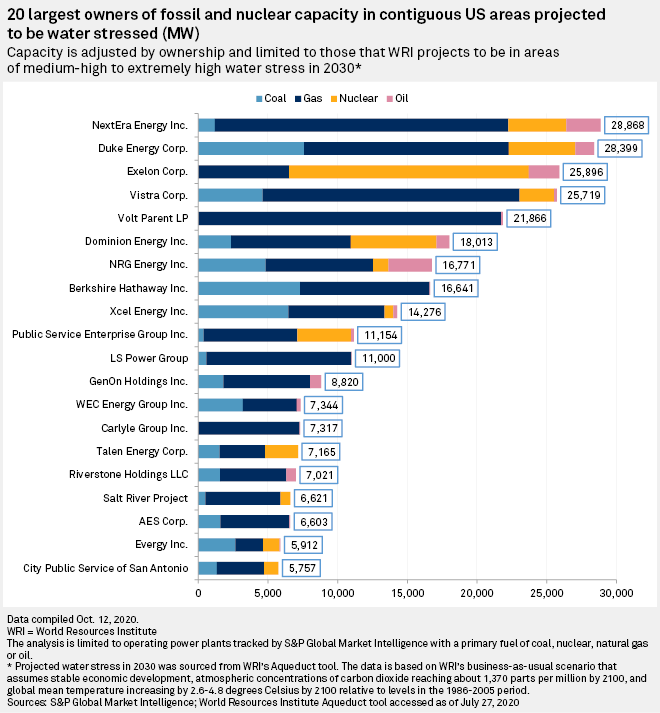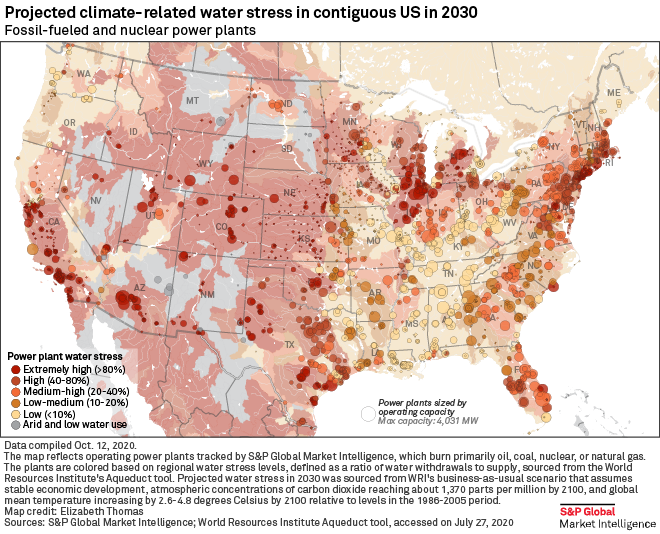Climate change poses big water risks for nuclear, fossil-fueled plants
- Author Esther Whieldon Taylor Kuykendall
- Theme Energy Banking

| Exelon Corp.’s Clinton Power Station nuclear plant in Illinois uses about 248.5 billion gallons of water annually, the utility said in its 2020 report to CDP. The plant is in an area projected to face increased water stress by 2030. Source: Exelon Corp. |
As global warming climbs and humanity’s water consumption increases, nuclear and fossil-fueled power plants that rely on freshwater for cooling may not be able to perform at their peak capacity or could be forced to shut down temporarily even as demand for their supplies for indoor cooling and other uses increase, according to researchers and industry experts.
Climate change-exacerbated water shortage issues pose a near-term and longer-term performance risk to power plants, such as hydropower and nuclear, around the world. And in the Lower 48, more than half of the fossil-fueled and nuclear fleet is located in areas forecast to face climate-related water stress by the end of this decade under a business-as-usual scenario, according to an analysis by S&P Global Market Intelligence.
Part 1: Climate impact on water supplies puts squeeze on hydropower Part 2: Climate change poses water risks to nuclear, fossil-fueled plants Part 3: Rising water stress risk threatens US coal plants, largely clustered in 5 states |
But electric utilities’ overall exposure to power plant water stress risks could diminish as they pursue decarbonization strategies and replace water-dependent plants with wind and solar generation that require little to no water. Some companies are also implementing water management and related investment strategies to reduce their exposure.
Water issues have become more and more important to utilities over time, said Alex Bond, Edison Electric Institute’s associate general counsel for energy and the environment. EEI is an association of U.S. investor-owned utilities.
Bond said water stress is one component of resilience that utilities currently monitor and analyze. “Our companies take electric sector resiliency very seriously,” he said.
According to projections from the World Resources Institute’s Aqueduct Water Risk Atlas, water stress — when humanity’s competition for water exceeds the rate at which nature can replenish its stocks — could grow materially by 2030 in the drought-prone Western U.S., as well as the upper Midwest and portions of the Northeast and Florida, due to climate change.
About 61.8% of existing fossil-fueled and nuclear power plants in the Lower 48, or a combined 535 GW of operating capacity, is in areas that could face medium-high to extremely high water stress in 2030, based on an analysis of Market Intelligence’s power plant data paired with the Aqueduct water stress projections.
Moreover, 68.6% of the Lower 48’s natural gas-fired fleet, 73.3% of its oil-fueled fleet, 61.0% of its nuclear fleet, and 44.6% of its coal-fired fleet are in areas expected to face medium-high to extremely-high water stress that year.
“As we’re seeing snowpack decline — a natural mountainous reservoir of water — and as we’re getting lower amounts of total precipitation and available water in the U.S. West, this is going to be a really serious issue for the power sector,” said Betsy Otto, director of the Global Water Program at the World Resource Institute, or WRI. Moreover, scientists have said the West is entering a megadrought that could last more than 20 years.

Otto also noted that several other U.S. regions not normally thought of as facing water supply issues are already experiencing chronic water challenges that, if left unchecked, could become a problem if extended droughts, heatwaves, and other major extreme weather events should occur.
A number of utilities use WRI’s Aqueduct tool to assess their water risks in their annual reports to the CDP, formerly known as the Carbon Disclosure Project, and other organizations. But those reports typically focus on the WRI’s current water stress models and not the tool’s future climate projections.
WRI’s current water stress models show a number of regions that are facing water stress will be in the same situation, or worse, at the end of the decade.

Along those lines, Moody’s Investors Service in August reported that about 48 GW of nuclear capacity across the U.S. face elevated exposure to combined heat and water stress, including plants owned by Exelon Corp., Vistra Corp., Entergy Corp., and the Arizona Public Service Co.
In hot water
A plant’s location is not the only factor that will determine its vulnerability to water stress. A plant’s water source, cooling technology and the temperature of the water when it is withdrawn are also key factors, according to scientific reports. The Market Intelligence analysis using the WRI tool does not account for those three factors.
In addition, rising ambient air and water temperatures can also create operational and legal issues for plants. Because plants primarily use water to cool their systems, “if that water is hot or warmer to start with, that’s not so good. That makes the power plant less efficient” and it also means the plant risks violating federal restrictions on how hot water can be when it is discharged, said Auroop Ganguly, director of the Northeastern University College of Engineering Sustainability and Data Sciences Laboratory.
Ganguly co-authored a study that found that by the 2030s, climate-induced water stress in the form of increased water temperatures and limited freshwater supplies will hurt the power production of thermoelectric plants in the South, Southwest, West and West North Central regions of the U.S. According to the 2017 study, U.S. nuclear and fossil-fueled plants at that time used about 161 billion gallons per day, or 45% of the nation’s daily freshwater usage, 90% of which was for cooling.
The technologies used by a power plant can also make a big difference in how much water it needs. Dry-cooling technology uses very little water but is costlier and less efficient than alternatives. And while once-through cooling systems withdraw more water than recirculating systems, once-through cooling returns nearly all of the water to the source while recirculating systems consume more water due to evaporation.
How the clean energy transition can help
Some of the utilities that have power plants in water stress-prone areas have set ambitious decarbonization goals, including to achieve net-zero emissions by 2050 or sooner. As such, the utilities are accelerating their investments in wind and solar power facilities that use virtually no water, and natural gas-fired units that use less water than coal and nuclear plants. As a result, utilities are finding that their total water consumption is declining.
Duke Energy, which has a net-zero emissions target, reduced its water withdrawals for electric generation by 12% over three years from 5,293 billion gallons in 2017 to 4,657 billion gallons in 2019, according to Duke’s 2019 sustainability report. Duke has about 28,000 MW of generation in areas projected to face climate-related water stress in 2030. In its 2019 water report to CDP, Duke said that as it switches from once-through cooling to closed-cycle cooling and renewables, it expects its water usage to further decrease.
Duke in an email indicated that in 2019, all of its power plants were in areas ranked low or low-medium for water quality risks and only three stations were ranked with an overall risk of medium-high.
“All three of those stations are located on reservoirs where we engage with our stakeholders on water issues,” spokeswoman Kim Crawford said. She also noted that some plants, including two in Florida that the Aqueduct tool projected would face water stress in 2030, use reclaimed water for cooling through partnerships with local governments.
And WEC Energy Group, Inc.’s subsidiaries We Energies and Wisconsin Public Service Corp. have substantially reduced their combined cooling and process water use and total discharges from its power plants by switching from some coal-fired generation to gas-fired generation and adding renewable electricity, according to WEC spokesperson Alison Trouy.
Similarly, NextEra Energy Inc., which has the largest total generation capacity in U.S. areas projected to face water stress, in its latest environmental, social and governance report noted that it avoided the use of more than 14 billion gallons of water in 2019 through investments in wind and solar power.
Moreover, NextEra said nearly 80% of the water its power plants withdrew in 2019 came from seawater sources, which are “not subject to drought.” According to NextEra, only two of its plants are in areas that currently have high or extremely high water stress, and those plants make up less than 1% of the company’s total water consumption.
Utilities take steps to tackle water risks
However, NextEra has encountered water stress issues in the past. At the company’s Turkey Point Nuclear and gas unit in Miami-Dade County, Fla., a drought in 2014 drove up the water temperatures in the plant’s one-of-a-kind canal cooling system, and the utility had to obtain a federal waiver to exceed the plant’s cooling system 100-degree limit to keep the plant operating.
NextEra has worked on longer-term water solutions for the plant. In June 2020, the Miami-Dade County Commission approved subsidiary Florida Power & Light Co.’s proposal for a project that would use 15 million gallons per day of the county’s reclaimed wastewater to cool unit 5 of the Turkey Point plant. Currently, brackish water from the Floridian aquifer is being used for the cooling towers.
Another utility that uses recycled water from local cities is Salt River Project, which generates electricity and provides water in the Phoenix metropolitan area. SRP uses its water expertise to “ensure that our power plants have access to reliable water sources, including back-up supplies in times of drought,” SRP Director of Water Strategy Christa McJunkin said in an emailed statement.
McJunkin noted that many of SRP’s power plants have access to multiple water sources and that the Palo Verde nuclear plant, of which SRP holds a 17.5% ownership, relies entirely on effluent water from major cities. SRP also has a goal to reduce its water use at power plants by 20% from 2005 levels by 2035, McJunkin said.
Exelon, which has about 25,900 MW of generation in areas projected to have water stress due to climate change, has a fleet of hydropower, nuclear and fossil fuel plants that collective rely on more than 40 billion gallons of water a day, the vast majority of which is returned to the water source.
In its annual water report to CDP in August 2020, Exelon noted that it has a drought monitoring task force that reports to the company’s executive committee. And the company is installing monitoring systems in water-stressed areas. Based on projected increased temperature and droughts in Texas, Exelon decided to use dry cooling technology for two combined-cycle gas plants it brought online in 2017. Those plants are Wolf Hollow II and Colorado Bend Energy Center II, which are projected to be in areas with high and medium-high water stress in 2030, respectively.
Water rights contracts can also help utilities mitigate their water risk, said Joe Smyth, a research and communications manager with the Energy Policy Institute who authored a July 2020 report examining coal and water conflicts in the American West. A number of utilities rely on those water rights contracts to ensure they have what they need, he said.
For example, Evergy Inc., which has about 5,900 MW of generation capacity in areas projected to face water stress, said in an email that it manages water risk associated with its operations through a combination of water supply rights, drought assurance contracts and water contracts. Evergy also monitors its water usage and implements projects as needed to reduce water use and impact, said the email.
Public power utilities are also moving to address water risks. City Public Service of San Antonio, which has about 5,760 MW of generation in locations projected to face water stress, has drought management plans in place. Like other utilities, it has decreased its water use by closing coal plants and adding renewable generation, CPS Energy spokesperson Nora Castro said.
“We cannot make electricity without water, and water cannot be pumped at the scale San Antonio needs without electricity, so we have placed great value and respect for our precious water resource and take steps regularly to ensure it is protected,” Castro said in an email.

